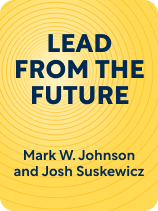

This article is an excerpt from the Shortform book guide to "Lead from the Future" by Mark W. Johnson and Josh Suskewicz. Shortform has the world's best summaries and analyses of books you should be reading.
Like this article? Sign up for a free trial here.
What’s future-back thinking? How can it boldly take your business into the future?
In Lead From the Future, business strategists Mark W. Johnson and Josh Suskewicz argue that, to drastically improve your organization’s chances of successful growth in the long term, you must anticipate and shape the future rather than simply react to challenges as they arise.
Read more to learn about this approach and how it can work for your business.
Why Use Future-Back Thinking
No one can predict the future. But, as a business leader, you can improve your organization’s longevity, relevance, and growth in the long term. To do so, you must change your focus from short-term concerns and time horizons to the future you want to see five to 10 (or more) years out.
The authors explain that future-back thinking allows you to respond to changing market realities by anticipating threats and opportunities on the horizon, thinking outside your company’s established processes and approaches, reinventing your business or an aspect of it, and meeting unmet demands in the market with innovative products, services, and processes.
Additionally, the authors explain that the future-back thinking approach can be applied to different types of organizations other than businesses.
(Shortform note: It’s true that future-back thinking can apply to different organizations, though in sustainability and climate crisis planning, it’s called backcasting. Backcasting can help identify strategies and actions to achieve a desired future state, such as a low-carbon economy. Similarly to future-back thinking, backcasting starts with setting a long-term goal, such as reducing carbon emissions by a certain percentage by a specific year, and then working backward to identify the actions needed to achieve that outcome.)
Why Present-Forward Thinking Is Ineffective
The authors explain what the conventional, short-sighted mindset and strategic approach for business leaders is (what they call present-forward thinking) and why it leads to failure for many. Present-forward thinking happens when you focus solely on solving short-term problems, which leaves you unprepared for looming problems and opportunities. When senior leaders get stuck in present-forward thinking, they become attached to the past and reactive to the present. As a result, their companies grow rigid and get bogged down in their processes, regulations, and norms.
Present-forward thinking makes your business more vulnerable. This is because thinking and planning this way blinds you to transformative opportunities that could assure your company’s stability and growth. The authors explain that senior leaders often assume the future won’t look much different from the present and tend only to think one or two years ahead.
(Shortform note: In an interview on the Great Leadership with Jacob Morgan podcast, Mark Johnson elaborates on the current-state mindset, saying that it drives essential business operations like product development, marketing, and research and development, with the goal of serving current customers. These essential operations will make up 90% of your business’s daily operations. The problem arises when you assume you can extend current-thinking operations indefinitely—sooner or later, rapid changes in technology and customer expectations will likely render your current core offerings obsolete. Present-forward thinking has its place, but when that’s the only mindset you have, you’ll be unprepared for the future.)
The Foundation of Future-Back Thinking
According to the authors, it’s important to understand two foundational aspects of future-back thinking. Then, you can move through the three-stage process of future-back thinking. Let’s take a look at these two aspects.
Breakthrough Innovation
According to the authors, breakthrough innovation—innovation that creates new markets rather than just improving or updating current offerings—is at the heart of long-term growth and relevance. Even if your company is doing well currently, its growth will likely stagnate without effective breakthrough innovation strategies, and your company will fail in the long term.
The authors explain that established companies often overlook the importance of breakthrough innovation because they believe they can survive in the long term by focusing only on improving their company’s core offerings. These types of incremental core innovations aren’t enough on their own to ensure growth and longevity.
Additionally, many executives often overestimate the risks of investing in such innovations. But, the authors argue that you can manage these risks and, importantly, that the cost of not taking innovation risks is much higher than sticking to safer incremental innovations.
The Discovery Cycle
The other foundational aspect of future-back thinking is an exploratory, cyclical learning approach in which you investigate, imagine, and experiment to develop insights and solutions to problems and opportunities. The steps of the discovery cycle are:
- Investigate: Explore possibilities and develop insights and assumptions about the problem or opportunity by collecting information.
- Imagine: Brainstorm solutions to the problem or innovative ideas.
- Experiment: Test your ideas to yield more insights. Take the insights you gain and return to step one to investigate and develop them further.
This approach supports the future-back thinking process, which is dynamic and constantly evolving in response to changing environments and new insights.
| Mastering the Discovery Cycle With Discovery Skills The discovery cycle steps echo the essential Discovery Skills outlined in The Innovator’s DNA. These five skills—associative thinking, questioning, observing, idea networking, and experimenting—are similar to the discovery cycle steps as they can help you further develop innovative ideas and solutions: Associative thinking involves making connections between seemingly unrelated ideas, concepts, or experiences to generate innovative solutions. In questioning, you question common assumptions about markets and products. Observing involves carefully watching and learning from how people interact with a product. Experimenting entails taking a hands-on, iterative approach to test ideas, hypotheses, and prototypes in order to learn and refine innovative concepts. Idea networking involves actively seeking diverse perspectives and engaging in collaborative conversations with individuals from different backgrounds to generate new ideas. Step One of Johson and Suskewicz’s discovery cycle (investigate), encompasses questioning and observing. Step two (imagine), includes questioning and associative thinking. And experimenting with ideas through testing is shared by both the discovery cycle and Discovery Skills. Idea networking is inherent in future-back thinking dialogues. |
The Three Stages of Future-Back Thinking
The authors break the visionary process into three stages. They explain that they don’t intend for you to use these stages as a rigid checklist but, instead, as a flexible framework that you can adapt. The stages of future-back thinking work best as a collaborative process that includes regular, structured dialogues between senior leaders informed by the discovery cycle process.
(Shortform note: Collaborative, exploratory dialogues can be challenging when there are many people with different perspectives at the table. To overcome these difficulties, Kim Scott outlines seven key steps to successful team collaboration in Radical Candor: listening, clarifying, debating, deciding, persuading, executing, and learning. However, although some aspects of future-back thinking entail making impactful decisions, Johnson and Suskewicz emphasize that your dialogues should focus on exploring over decision-making and executing. Therefore, you could visit Scott’s steps of deciding and executing later in the future-back thinking process after you’ve sufficiently moved through the other five steps.)
Stage 1: Create Your Vision
This stage involves three steps:
- Anticipate the future landscape. Identify a time horizon—how far into the future to set your vision for the company. Consider when new paradigms and trends may become relevant and mature enough to create market disruptions.
- Think about how your business will fare in the future. Examine potential threats and opportunities, and determine which is likely to play a larger role in your future so that you can develop a strategy to either respond to threats or take advantage of opportunities.
- Construct a future vision. Describe what services or products you’ll offer, how you’ll create value in the market, and how you’ll address necessary factors in future growth. To solidify your vision, the authors recommend you develop a compelling story that describes it.
Stage 2: Convert Your Vision to Strategy
Now that you have a future vision, you must convert it into a strategy that will bring your vision to life. According to the authors, your strategy contains three connected components (which they call portfolios). These components are interdependent and respond to change. You must look at all three together to get a holistic view of your visionary plan and update each component as new insights emerge.
- Develop a long-term financial picture of your business. This helps you estimate the revenue and profits your future vision will likely yield. First, identify a growth target that aligns with your future vision. Then, calculate what the authors call your growth gap and figure out when your growth gap is likely to develop.
- Develop an innovation roadmap. This outlines the steps you need to take to achieve your growth target. It includes your company’s core, proximate, and new growth projects, and any undertakings that will develop the company’s capabilities to support growth.
- Develop a resource plan. This outlines where you’ll invest your financial resources and human resources and where those resources will come from.
Stage 3: Realize Your Visionary Plan
At this stage, you’ve formed a vision and developed a new growth strategy in service of your vision. To realize your visionary plan, you must structure your teams to embody your strategy and then execute it. There are two steps in this stage:
- Structure your organization to carry out your strategy. Involve your senior leadership, position your breakthrough innovation teams for success, and establish a discovery cycle process to oversee new projects.
- Execute your strategy. This has three phases:
- In the gestation phase, you test the important assumptions you’ve made about the future landscape. Gestation typically lasts two to three years.
- In the expedition phase, your focus shifts away from testing your assumptions and toward standardizing processes, establishing rules, and defining metrics to measure your efficiency and profitability. Expedition typically lasts two to four years.
- In the evolution phase, you must decide whether to integrate your new growth initiatives into the core business or keep them separate. Evolution typically lasts one to three years.
Make the Future-Back Thinking Approach a Part of Your Organization
The authors emphasize that future-back thinking is not just a process you go through once and then are done with. In order to ensure growth and relevance for your organization in the long run, you must make future-back thinking a continued part of how the organization operates. To do so, you must elevate and encourage visionary mindsets and skills in your leaders (including yourself) and institutionalize future-back thinking as part of your organization’s processes.
(Shortform note: The authors of The Innovator’s DNA add that to embed a visionary and innovative mindset in your organization, you must also structure your teams in a way that helps team members develop and use the skills and mindset you wish to encourage. Team members’ skills should balance and complement each other—assess each member’s strengths and form your teams based on what each person brings to the table.)
The Visionary Mindset and Skills for Leaders
Leaders with a visionary mindset and skill set successfully implement the future-back thinking process and pass their skills and perspectives along to the teams they oversee. The authors explain that visionary thinkers don’t possess a mysterious set of rare traits that make them uniquely capable of envisioning possibilities and mobilizing opportunities—they simply work to keep a broad perspective, and they maintain an optimistic attitude about the possibility of change. Additionally, to be a successful visionary leader, the authors recommend you do the following:
- Become familiar with the discovery cycle process and get comfortable investigating, envisioning, and experimenting with ideas.
- Develop the mental flexibility to switch between present-forward thinking and future-back thinking.
- Continually rethink and reshape your visions for the company’s future based on emerging data.
(Shortform note: In The Leadership Challenge, James Kouzes and Barry Posner also argue that leadership is a skill you can improve through conscious effort, and many of their recommendations for effective leadership mirror those of Johnson and Suskewicz. However, while Johnson and Suskewicz emphasize improving your mental agility through the techniques listed above, Kouzes and Posner focus on building relationships with your team members. One way to do this is to recognize and celebrate the contributions of team members, which can help to foster a positive and supportive work environment.)
Organizational Processes
To build a future-back thinking mindset into the processes and structures of your organization, you must create a culture where no one is afraid of being judged for exploring and developing their talents, as this limits people’s ability to imagine the future and innovate. Foster an egalitarian company culture that values everyone’s ideas. Additionally, it’s important to prioritize inclusiveness and demographic diversity because differing perspectives contribute to a broader understanding of your customers and open-mindedness to new ideas on every level of the organization.
(Shortform note: Creating an environment that embraces experimentation and diversity is a key aspect of establishing what experts call psychological safety within the workplace. Psychological safety is necessary for innovation: When employees feel apprehensive about potential repercussions for mistakes or non-conformity, it hampers their ability to have visionary and innovative mindsets, think critically, unleash their creativity, and solve problems. Other strategies to cultivate psychological safety include promoting collaboration, bolstering employees’ confidence through positive feedback, and actively seeking their input on ways to enhance the organization’s culture and systems.)
The authors explain that it’s important to tirelessly communicate your vision and larger purpose with your employees to ensure everyone understands it and knows how they can contribute to it. Studies have shown that being connected to the larger mission improves productivity and employee retention. Additionally, it’s essential to have clear, concrete goals that employees, customers, and investors can connect to and support. By having a clear vision and purpose and communicating it effectively, you can cultivate a future-back thinking mindset throughout your organization.
(Shortform note: In What You Do Is Who You Are, Ben Horowitz argues that what leaders communicate to their team members through their words and behaviors creates a blueprint for the company’s culture which greatly affects employee behavior and performance. He explains that you should create your company’s culture with intention. When an organizational culture is deliberately designed, it aligns with the company’s vision and larger purpose. This in turn makes it clear to employees how to contribute to the company’s progress. The way to establish a healthy company culture, according to Horowitz, is to lay a foundation of values, model those values as a leader, be inclusive, and continuously strive to improve your culture.)

———End of Preview———
Like what you just read? Read the rest of the world's best book summary and analysis of Mark W. Johnson and Josh Suskewicz's "Lead from the Future" at Shortform.
Here's what you'll find in our full Lead from the Future summary:
- Why it's important to anticipate future change rather than reacting to it
- A three-stage framework for staying ahead of the competition
- How to understand and adopt the visionary planning process






